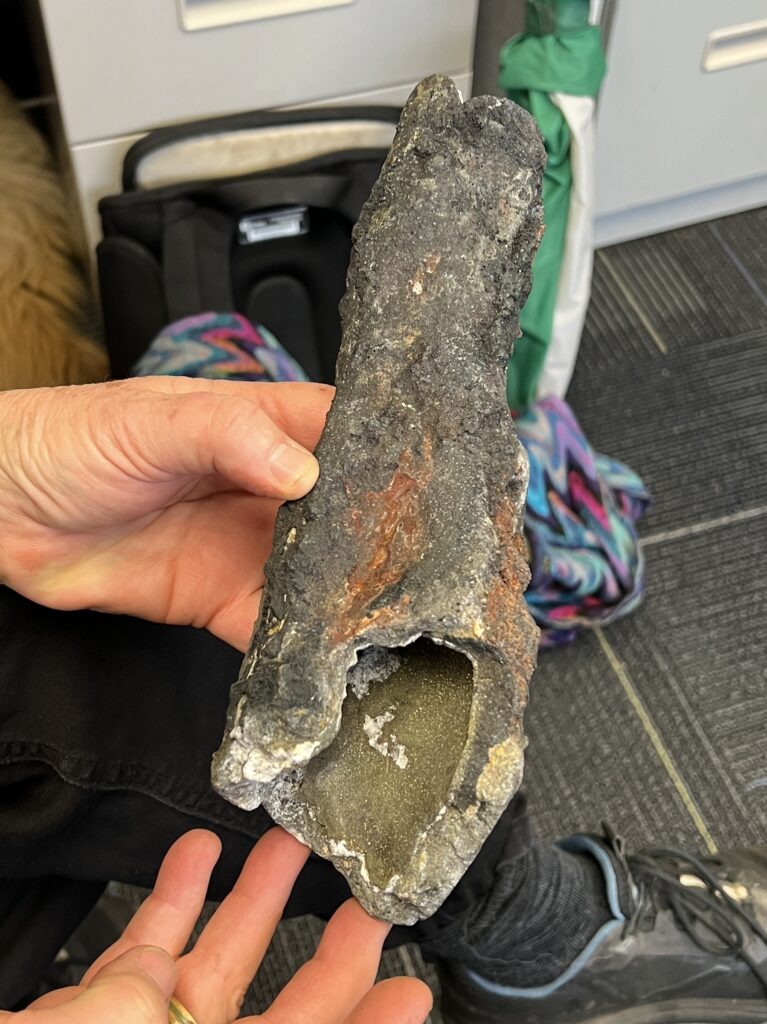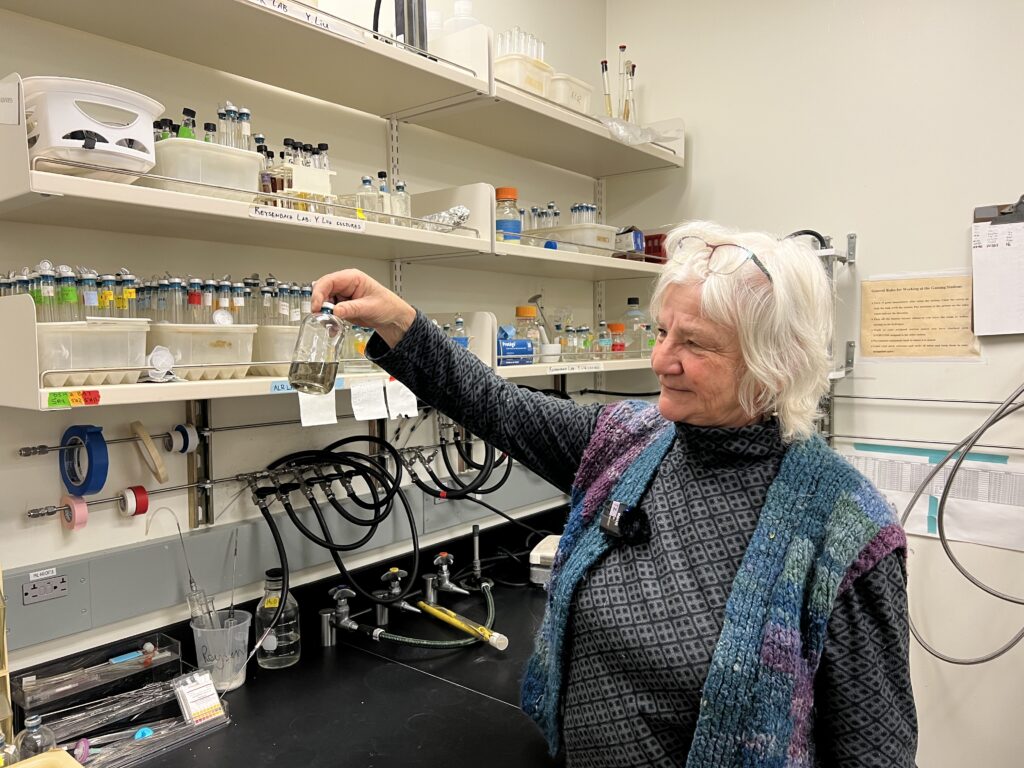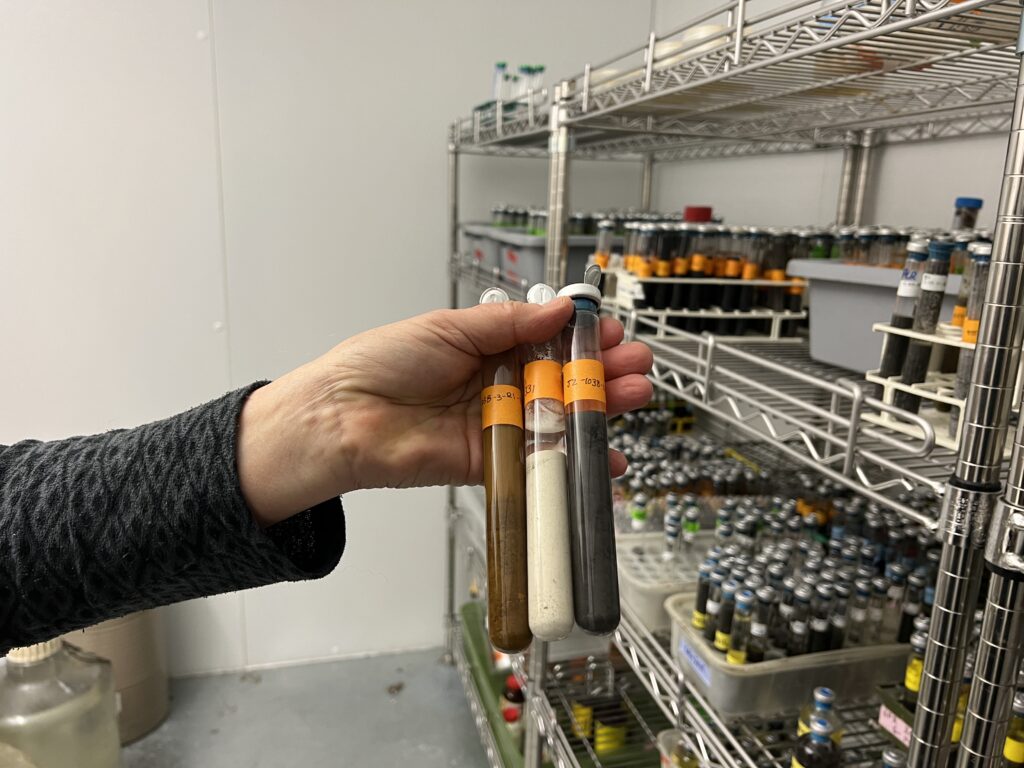The ocean depths are vast and dark. But there are hotspots on the ocean floor — underwater volcanoes and hydrothermal vents — where lively microbial communities thrive, and even support entire ecosystems. Hear from researchers Anna-Louise Reysenbach, Emily St. John, Gilberto Flores, and Peter Girguis about sampling these communities, and understanding how they’ve adapted to this extreme environment. Find show notes here.
Episode Transcript:
<STING: This is a production of the Joint Genome Institute. The JGI.>
Menaka: Today, a trip to the bottom of the ocean. It’s a mega trip to sample some microorganisms. We’re going on a research cruise.
Anna-Louise Reysenbach: Basically, we have to get on a ship somewhere in the world, and set up a lab on the ship. So you bring all your equipment and your, you know, all your pipettes and everything else,
Menaka: And from that ship, this trip takes us into a submarine. It’s a titanium metal sphere,
Gilberto Flores: Maybe a little bit wider than a typical car. You don’t drink coffee that morning because anything that happens in the sub stays in the sub with you. And so there’s three people in there. There’s the pilot and then there’s two science observers.
Menaka: Sounds like it’s you, me and the pilot today, fueled by enthusiasm. And we’ve got a destination to head to. It’ll be a crack in the Earth’s crust. A hydrothermal vent.
Peter Girguis: Hydrothermal vents are hotspots, literally, on the seafloor where sea water has been cooked in the subsurface in the presence of rocks. And that chemically changes it all.
Menaka: So those vents are where we’re headed, all the way from the surface. We’ll drop about a mile and a half down.
Gilberto Flores: It takes about an hour-15 of just falling in the submarine. <bubbles>
Menaka: And while this submarine sinks down to the ocean floor, here’s a little more about how these hydrothermal vents work. They start with shifts in the Earth’s tectonic plates, beneath the ocean.
Anna-Louise Reysenbach: So as plates are pulling apart, cracks will develop in the Earth’s crust and seawater will percolate down. And it keeps going deeper and deeper down into the earth’s crust. It starts to get heated, deep in the earth’s crust.
Menaka: At that point, the sea water goes through a transformation. It’s hitting these very hot rocks inside of the Earth, reacting with their minerals and metals.
Anna-Louise Reysenbach: And so what was initially seawater will eventually just become this very different fluid, which is full of minerals, full of gasses and very hot.
Menaka: And that heat will eventually push this hydrothermal fluid back up, to the seafloor. So it’s fizzy and full of minerals, over 570 degrees fahrenheit (300 degrees celsius), and it’s shooting out of a crack in the ocean floor, into the surrounding seawater.
Anna-Louise Reysenbach: And it looks like chimneys, or smoke from a chimney.
Menaka: We’re talking like, black clouds, billowing up from the ocean floor, underwater. And over time, as those clouds of hydrothermal fluid collide with sea water, they react and leave behind solid structures.
Anna-Louise Reysenbach: When the hydrothermal fluid then mixes with sea water, all those minerals in the hydrothermal fluid will precipitate out. And they make these structures called chimneys. or hydrothermal deposits.
Menaka: If you’ve ever been inside a cave, and seen those mineral formations growing down from the ceiling? These look a little like that. Except, they’re growing upward from the ocean floor. And they’re more active than most mineral deposits.
Anna-Louise Reysenbach: Those deposits can, can grow up to a half a foot a day or more.
Menaka: They’re a frenzy of heat, minerals and gasses, underwater. So, there’s a lot going on where we’re headed. On the way, conditions will change.
Gilberto Flores: Once you get down to certain depths, the sun can’t penetrate, it does start getting cold. So they do have some wool blankets in there for you.
Menaka: And so will the views out the window.
Anna-Louise Reysenbach: It’s just alive. The ocean is alive with fluorescence, bioluminescence. It’s amazing.
Menaka: Eventually, we’ll get down to the sea floor. It’s totally dark. But we’ve got lights to guide the way, as we navigate toward a hydrothermal vent. We’ll use signs from the sea to find our way there.
Gilberto Flores: And then as you start approaching the hydrothermal vent field, the water will get a little cloudier.
Anna-Louise Reysenbach: We also look for animals. Animals are big indicators. There’s certain shrimp that come in, certain crabs, certain fish.
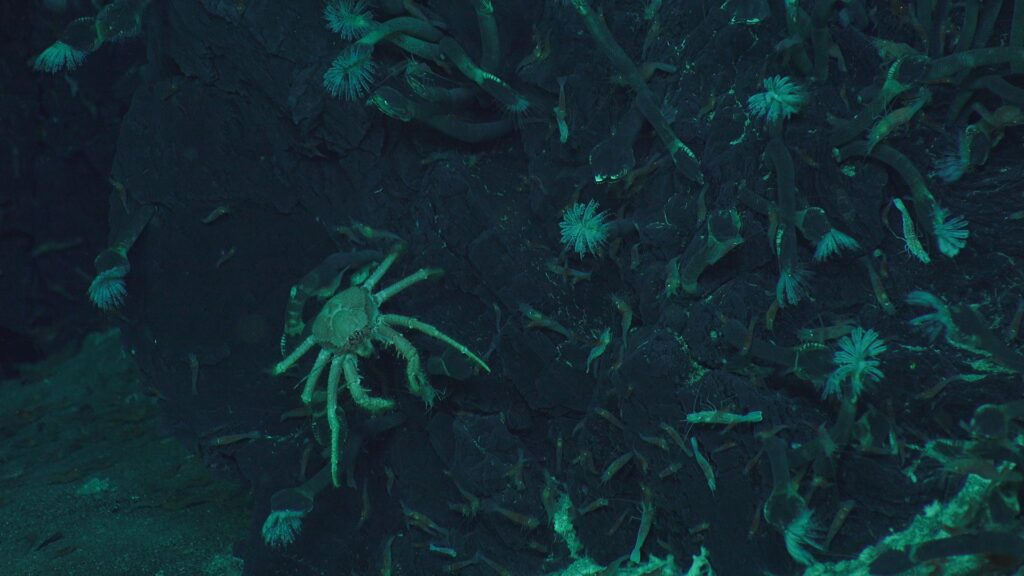
Microbes support a lively ecosystem of crabs, shrimp and anemones at the ocean floor. (Woods Hole Oceanographic Institute and NSF)
Peter Girguis: And you start looking for what sometimes people joke, it’s jokingly called like a crab gradient. You’re like, Ooh, there’s a crab. It’s white, it’s probably a vent crab. And you follow it until you see more and more, and eventually you come across a vent. But that whole ecosystem really depends on the microbes.
Menaka: And we’re interested in that first line of this ecosystem — the microbes that feed the crabs and shrimp and fish. Underwater, they just look like bits of fuzz, stuck to rocks, the seafloor, and crabs. But they’re supporting an entire ecosystem, without any sunlight. They’re tiny little powerhouses. So in this episode — the researchers looking at these microbes. They’re microorganisms that have evolved to create energy from that frenzy of heat, minerals and gasses that is a hydrothermal vent.
<THEME>
Menaka: This is Genome Insider from the US Department of Energy Joint Genome Institute. Where researchers discover the expertise encoded in our environment — in the genomes of plants, fungi, bacteria, archaea, algae and environmental viruses — to fuel a more sustainable future. I’m Menaka Wilhelm.
And going in the sub was so exciting, I haven’t introduced anyone yet. Here’s who we’ve heard from so far.
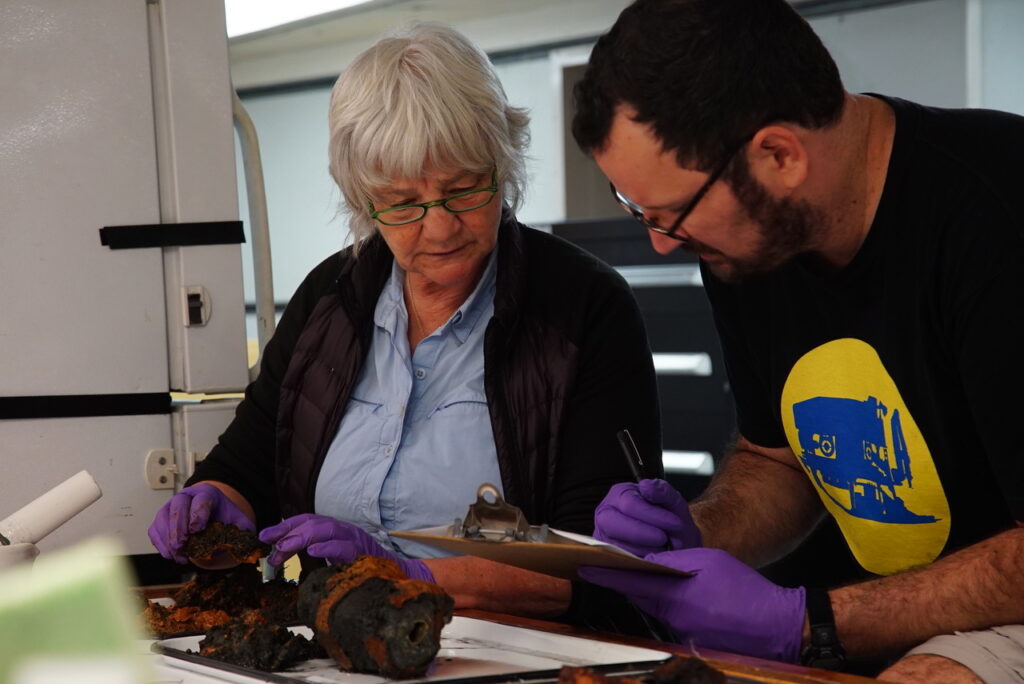
Anna-Louis Reysenbach (left) and Gilberto Flores (right) examine a rock sampled from an eruption at the ocean floor. (Eric Olson)
Gilberto Flores: I’m Gilberto Flores. I’m an associate professor in the department of Biology at California State University Northridge.
Peter Girguis: My name is Peter Girguis. I’m a professor of organismic and evolutionary biology at Harvard University.
Anna-Louise Reysenbach: So I’m Anna-Louise Reysenbach, and I am professor of Biology at Portland State University.
Menaka: Together with the rest of their team, these three researchers have visited ocean floors around the world. From those expeditions, they’re working to understand the microbes that make a living in an environment so extreme it would be hard to dream up. Hydrothermal vents exist in total darkness. But what they lack in light, they make up for with heat and chemistry. The microbes living there manage to fix carbon, and cycle nutrients, within that bizarre set up.
So our researchers have headed down to collect these organisms. Sometimes they use a submarine, and other times they use a remotely operated vehicle. Either way, a robotic arm handles the pressure at these ocean depths, and collects rocks to bring back to their labs on land. When I heard that, I was super curious about what those rock collections would be like.
<outsides sounds fade in>
Menaka: I got to find out.
Menaka: Hi, this is Menaka
Anna-Louise Reysenbach: This is Anna-Louise.
Menaka: I am at the door outside the loading dock.
Anna-Louise Reysenbach: Okay. I will, come on down.
Menaka: Okay. Awesome.
Anna-Louise Reysenbach: Okay. Cheers, Bye.
Menaka: So that’s Anna-Louise Reysenbach. Her lab is in a brick building at Portland State University, right in the middle of the city. I meet her on a very rainy Monday. And we head down a hallway painted bright lime green to chat in her office before we take a look at all the rocks in her lab.
Anna-Louise Reysenbach: So this is kind of where I’m based. I’ve got a culture collection next door, I can show you
Menaka: And I got to find out. I also meet an office mate, <Layla painting: > Anna-Louise’s dog! She’s a fluffy brown pup. And I think if she stood on two paws, she’d be taller than me. I’m 5’6.
Menaka: What’s her name? Layla. Layla.
Anna-Louise Reysenbach: Layla. Layla. Layla. <laughs>.
Menaka: Anna-Louise’s enthusiasm shines onto her work, too. She got in on the ground floor of this research field. Or, you could say, the ocean floor.
Menaka: How did you get started studying underwater microbes?
Anna-Louise Reysenbach: Well, deep sea hydrothermal events got discovered in 1977.
Menaka: So that was while she was in school. She did her PhD at the University of Cape Town in South Africa, and trained in anaerobic microbiology — she learned how to grow difficult microbes in the lab. She also learned to scuba dive. She’d always loved the sea.
Anna-Louise Reysenbach: And so I decided that for the rest of my career, I needed to combine my love for the ocean and water and ecology with my career.
Menaka: Hydrothermal vents presented an ideal combination. She’d work with microbes, the ocean, and big challenges. She started out understanding these microbes by cultivating them. So she’d take a sample, feed those microbes her best guess at the minerals and nutrients they’d like, and hope for the best.
Anna-Louise Reysenbach: I was always very frustrated that I could, I knew there were so many other things under the microscope, but you know, I could only grow one or two of those things. And I kept wanting to know, “who are all these other things in there?”
Menaka: Genomic sequencing changed everything. She could get a much more full list of the organisms in a sample, just by looking at their RNA or DNA.
Anna-Louise Reysenbach: Suddenly we could see that, you know, the microbial world was not just these few cultures, but, but much more diverse. And that was very exciting. And, you know, it just really exploded for me. Which, I’m almost in tears. I get so emotionally passionate about it, you know
Menaka: When she tells me about this, she kind of fakes wiping a tear away,
Menaka: <laughs> Are you okay?
Anna-Louise Reysenbach: No, I’m just kidding.
Menaka: Mostly.
Anna-Louise Reysenbach: You know, it was unbelievable that you could actually see the microbes, ‘see’ in quotes, the microbial world suddenly.
<STING>
Menaka: So — of all the places on Earth, our researchers wanted to use genomic goggles to look at the deep, dark ocean. It’s a super fascinating environment, which is how this project got started. But our researchers know — that might be a bit of a surprise. Peter Girguis, again:
Peter Girguis: 80% of our planet’s living space is deep ocean beyond the reach of sunlight. And we have this tendency as humans to think of this vast, homogeneous space as just that — vast and homogenous.
Menaka: But there are two environments on the ocean floor that really stand out. Underwater volcanoes, where liquid magma erupts from the seabed, and hydrothermal vents, which shoot out hydrothermal fluid. In both cases, there’s this extremely hot eruption that’s coming through, essentially, a mineral deposit. If you’re a microbe who’s made a home there, outside of that deposit, you’re next-door neighbors with an intense geochemical event. It’s a unique set up.
Anna-Louise Reysenbach: So you can imagine that right across this wall of, of less than a centimeter. I mean, it’s very hot, you know?
Menaka: Yeah.
Anna-Louise Reysenbach: But it’s porous. So fluid is going in and out. And so a microbe is just “ah, perfect. Got a place to live and, and attach to.” I mean, I often say there, it’s basically sitting in a jacuzzi, you know, you’re just getting fed, given your snacks while you’re just hanging out.
Menaka: Perfect life.
Anna-Louise Reysenbach: Yeah, exactly. <laughs>
Menaka: Those snacks are a big part of what makes these microbes so interesting to study. They’ve evolved to live on very different stuff than the rest of the planet.
Peter Girguis: So hydrogen, to them, is what our food is to us.
Menaka: While we run on kale chips, or hot Cheetohs, or turkey jerky, other microbes and plants create energy using sunlight. These bacteria and archaea at hydrothermal vents chomp away at hydrogen and other chemicals, with help from carbon dioxide.
Peter Girguis: Carbon dioxide to them is what oxygen is to us. And whereas we give off CO2, they give off methane. And that process can happen without oxygen.
Menaka: They’ve got these little microbe metabolisms that are totally different from other organisms on earth. And they live that way because that’s what they’ve got to work with – without sunlight for photosynthesis, they’ve developed a different way of creating energy. Chemosynthesis. Here’s Gilberto Flores again.
Gilberto Flores: And so through chemosynthesis down there, it’s remarkable how much life there really is on what is generally a desert, on the ocean floor. You have these oases of life.
Menaka: These oases contain whole communities of organisms operating in these unique ways.
Anna-Louise Reysenbach: And so, like other environments, soils and everything, when we look at the biodiversity in these, we find lots of novel microbes, lots of novel biodiversity, lots of new genomes.
Menaka: And within those genomes, we might find new ways of doing things we’re interested in. Like converting carbon dioxide into other forms of carbon, to remove greenhouse gasses from the atmosphere. Or breaking down chemicals that are polluting waterways. But there might also be surprises. Organisms in extreme environments have a way of coming up with completely new capabilities. So, you can’t always know what you’re looking for – and that almost guarantees that you’ll find something interesting.
Peter Girguis: That’s right. So we can go in there with our a priori ideas and hypotheses, but at the end of the day, you know, studying these systems, it also poses questions, and provides insights into things we didn’t expect.
Menaka: That’s really why Peter proposed this project in the first place — When he had the idea, he’d been working in the deep ocean research community for a few years. He mostly focused on tubeworms that live near the hydrothermal vents. And he met Anna-Louise really early on.
Peter Girguis: My very first research expedition as a graduate student was off the coast of Washington and Vancouver, with my advisor Dr. James Childress Dr. Anna Louise Reysenbach happened to be on that cruise.
Menaka: On cruises like that one, Peter saw that there were microbes at these sites that were very interesting, too. Plenty of researchers were looking into them, but sample collection was so demanding, most groups focused on one vent site, or a couple sites. He wanted to make it possible to compare microbes across different geographies – something no one could do alone.
Peter Girguis: So when this project started, I reached out to members of the community and said, folks, why don’t we pool our samples and submit them to the JGI and create a database, really, that allows all people interested in hydrothermal vents to pick and choose from their data.
Menaka: And he doesn’t just mean his direct collaborators – he means anyone interested in these genomes.
Peter Girguis: This kind of open access science has been important to me since I was a graduate student when I faced many situations where more senior colleagues were less interested in sharing. And I thought, “well, that’s, that’s bizarre, like why would you do that?”
Menaka: In his view, sharing data just means more discoveries.<cinematic music here> So working with Anna-Louise and 6 other researchers, he submitted a proposal to the JGI in 2011.
Together, they would send in dozens of samples from six different hydrothermal vent sites. One site sat right in the middle of the Atlantic Ocean, another would be in the Pacific, between Fiji and New Zealand, and the other 4 sites were different spots up and down the west coasts of Mexico and Canada.
And they’d make that data available publicly, through the JGI’s data portals, so other researchers could use it freely, too. While Peter might use the data to understand microbes living in symbiosis with the tubeworms he studied, other researchers might focus more directly on microbes. One of those researchers was Anna-Louise Reysenbach.
When the sampling for this project happened, Gilberto Flores was a PhD student with Anna-Louise. And Peter is right – Gilberto and Anna-Louise wanted to compare microbes from across different locations, where geochemistry varied. They were curious about a lot of microbial questions.
Gilberto Flores: How the communities may be evolving in those different environments, how they’re related to one another, and really trying to tie it to, you know, what they may be doing down there functionally.
Menaka: So — now that we’ve got a bit of background covered, let’s get back to Anna-Louise’s office. As we’re talking, she grabs something from under her desk and hands it over.
Anna-Louise Reysenbach: So here’s one. You know,
Menaka: Very casual — but this is the first thing I’ll see from her undersea sampling. It’s hollow, about as long as a rolling pin, and tapered – so one end is skinnier than the other. In terms of texture, it kind of looks like it’s made of a big, lumpy charcoal briquette. But it’s not all black. Some sections are dusted lightly with a rusty powder, gold flecks, or white smudges.
Menaka: So this is part of a vent.
Anna-Louise Reysenbach: This is the chimney. Yeah.
Menaka: Okay.
Anna-Louise Reysenbach: So this is the chimney. So that’s, so the hydrothermal fluids coming from deep in the bottom of the ocean, comes up and mixes with sea water. And these things just keep precipitating out. And then eventually the rock gets hard. <knocks on it>
Menaka: I have to say, this is my first time ever being handed something that was once at the bottom of the ocean. But stay tuned – it won’t be my last time. And this chimney is hollow, but still weighs about as much as a sack of flour. It’s dense.
Anna-Louise Reysenbach: There’s layers of different minerals as, as these things, precipitate out. I mean, a lot of it’s like, iron pyrite or chalco-pyrite, so copper, iron, sulfur, some of it’s silica in here.
Menaka: All of those minerals have come from inside the earth – when the hydrothermal fluid reacted with rocks beneath Earth’s crust. And different sites in the ocean have different minerals, that influence the microbial communities that grow on a vent. Then the microbes will use that chemistry to grow.
Anna-Louise Reysenbach: But I can show you some more in the lab because
Menaka: Yeah,
Anna-Louise Reysenbach: Because the one, this one’s a very heavy hard one, but there’s some real, when they first form, basically their minerals are precipitated out so they’re soft, and they’re more almost like mud. And then with time, the amorphous minerals become crystallized and that’s how you get, more of a rock.
Menaka: So – in just a bit, we’ll head into Anna-Louise’s lab for more rocks and samples. But first, a quick break.
<Music up>
Allison Joy: The JGI supported this project via the Community Science Program. This program provides genomics resources for projects with Department of Energy relevance. And we accept proposals from scientists at all career stages. But you don’t have to take it from us. Here’s Peter:
Peter Girguis: I started working with the JGI on a project about hydrothermal vent animals, and what I took away from that is that the staff at the JGI were really interested in helping us ensure the success of the science. So a lot of what I’ve enjoyed about working with the JGI is it gives us an opportunity to submit samples, generate data that answers questions, and it brings with it a wealth of data that poses new questions and generates new hypotheses. Another thing I appreciate about projects through the JGI is it’s an opportunity to provide, data that is accessible to people at very different career stages. And so I came to know, Gilberto when he was a student, and it’s neat to see so many folks who were students just a few years ago now, you know, setting up to run their own labs. And so, you know, these kinds of projects are really great to bring people together from across different career stages, and different, sort of, geographies, right. Different institutions across the country and around the world.
Allison Joy: You can find out more about submitting proposals to the JGI on our website. Head to joint geno-dot-me slash proposals. And, hey – if you want to mix and mingle with our users and other stakeholders in person, consider attending our 2023 annual meeting. Visit jointgeno.me/jgi2023. We’ve also got a link to our website waiting for you, wherever you’re listening to this episode — either in the episode description, or the show notes.
<Music out>
Menaka: This is Genome Insider, from the JGI. To recap where we’ve been so far, we’ve walked through a research cruise to collect microbes from the ocean floor, around hydrothermal vents. These microbes live so deep in the ocean that there’s no sunlight. So researchers are curious about how they live on heat and chemicals alone. And one of those researchers, Anna-Louise Reysenbach, is showing me around her lab.
So into the lab we go! <Entering lab sounds > Someone else is working at the bench when we get there, and there’s music on.
Menaka -ALR Interview: Who’s playing?
Anna-Louise Reysenbach: Who’s playing?
Menaka: It’s Emmylou Harris, Linda Rondstadt, and Dolly Parton’s supergroup TRIO, of course. And as promised, this is about when Anna-Louise hands me the second thing I’ve ever touched from the bottom of the sea. This time it’s a rock. It’s about the size of a softball, dark brown, reddish, and powdery looking.
Anna-Louise Reysenbach: Just feel this,
Menaka: Okay.
Menaka: I’m expecting something like that dense first chimney earlier. But this rock weighs next to nothing.
Menaka: Oh, it’s so light.
Anna-Louise Reysenbach: That’s why I wanted you to feel it! Because it’s shocking!
Menaka: This rock is super light because it was collected at a different time than that hardened chimney I held before. This was collected as more of a mud of amorphous minerals.
Anna-Louise Reysenbach: So that’s all microbial mat, iron mat. That’s just slowly mineralizing.
Menaka: As it’s dried out, it’s full of tiny air pockets, rather than hardened minerals.
Menaka: And then where was that collected?
Anna-Louise Reysenbach: That was collected, north of New Zealand, at the Eastern Lau Spreading Center, so near Tonga. Between Tonga and Fiji.
Menaka: Wow, that’s amazing.
Anna-Louise Reysenbach: I know. It’s really cool!
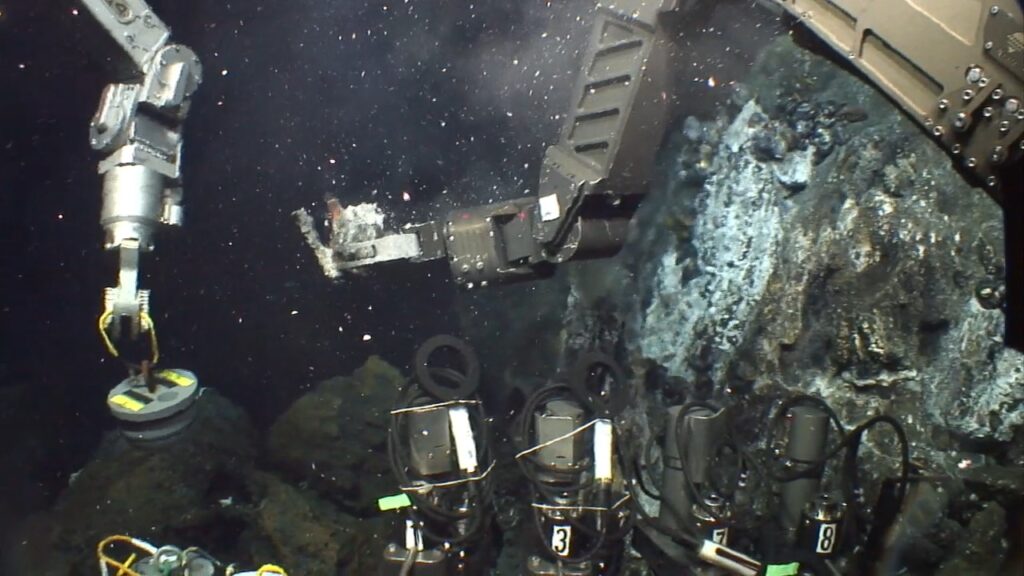
A robotic arm grabs a rock sample, thanks to a submarine pilot’s direction. (Woods Hole Oceanographic Institute and NSF)
Menaka: And, Anna-Louise points out that it’s even more amazing, when you think about how she got this sample. Outside of a submarine, a robotic arm plucked this mud from its place. Really, the submarine’s pilot used the robotic arm to grab the sample. They control a robotic arm with a claw on its end,
Anna-Louise Reysenbach: That’s like ice cream almost, right? The feeling, if you just squish it, it’s squished. So just think about taking those, that robotic manipulator and just very gently closing those little, little pincers and they were able to collect it.
Menaka: Wow. Yeah.
Anna-Louise Reysenbach: And keep it intact. I mean, that’s an art.
Menaka: Yeah. In a way. I mean, it’s like using a claw machine, but extremely gently.
Anna-Louise Reysenbach: Oh, yes very gently .
Menaka: She has lots of specimens that talented pilots have grabbed very gently with robotic manipulators.
Anna-Louise Reysenbach: So here’s, these are all rocks as well. I mean, I’ve got boxes of rocks,

Anna-Louise Reysenbach opens a drawer (instrument shown is a geiger counter) full of rocks collected from the bottom of the ocean, at hydrothermal vents and underwater volcanoes. (Menaka Wilhelm)
Menaka: They all look vaguely volcanic – because, they are. So they’re blackish hunks, dusted with reds, oranges and whites. Those are different minerals, and dried biofilms of microbes.
Anna-Louise Reysenbach: But these already been sampled. So we’ve removed the biofilm from the outside and then,
Menaka: So when you remove the biofilm, are you scraping it off?
Anna-Louise Reysenbach: Well, we use a spatula. Yeah. And we just scoop it more. So we’ll take, you know, like the first two millimeters or so of the surface off. And it’s pretty soft. I mean, you can see that it just, it just cracks off. And then we take that little sample and we homogenize it, and then we extract the dna.
Anna-Louise Reysenbach: And that’s what JGI gets, the dna.
Menaka: And now that we’re at the sending-DNA-to-the-JGI part of this story, we have another researcher to meet.
Emily St. John: My name is Emily St. John and I work with Dr. Anna-Louise Reysenbach at Portland State University in microbial ecology.
Menaka: Emily works on the bioinformatics side of analyzing all of these microbes. She’s never been on an expedition to collect samples in the ocean. Partly, that’s because many of the samples she’s working with predate her time working in this lab.
Emily St. John: I think our earliest samples from this study were 2004, so I would’ve been about 11 at the time. Yeah. Not really in any shape to go out to sea.
Menaka: Amazing.
Menaka: But she does remember sending samples into the JGI a few years ago.
Emily St. John: Yeah, us and Pete Girguis, it was a big, big shipment!
Menaka: Which makes sense. Remember, this whole study was aimed at sequencing a lot of samples, to find out how microbes from different sites would compare.
Emily St. John: So it allowed us to go from, you know pretty deep little study to a more globalized context and it also gave us the chance to have some, time study elements,
Menaka: So, for example — at one site, that Eastern Lau spreading center, between Tonga and Fiji, Anna-Louise had been collecting samples there for over a decade. They sent in microbes from multiple trips.
Emily St. John: So we could get some really old samples sequenced from the Eastern Lau spreading center and see, “How have these communities changed or not changed over the 10 years?”
Menaka: In ten years, you might expect a lot to change – Emily took a look at that data,
Emily St. John: And we see some of the same organisms still persisting, which is fascinating.
Menaka: Through the lens of bioinformatics, Emily also gets to take a look at other questions across the microbes at these hydrothermal vent sites.
Emily St. John: What are they using for carbon or energy, what diversity do they see? And then one of my favorite questions is, how are they interacting with each other? So can we see any evidence of symbiosis or mutualism organisms that meet each other to survive and thrive in these environments?
Menaka: In the last few years, Emily has thought about those questions with Anna-Louise and other researchers from the University of Wisconsin, Madison. This year, they published results from that work, analyzing some of the sequences they got back from the JGI. We’ll link to that wherever you’re listening to this episode. And let’s get into what they’ve found.
Emily St. John: This paper really shows that deep sea events and undersea volcanoes — we looked at both — are just exploding with diversity. And the more we look, the more we find, which is something I absolutely love in bioinformatics.
Anna-Louise Reysenbach: But then the funny thing is that, um, even though the phylogenetic diversity is very distinct in different places, in many cases, you know, the basic ecological function of the microbes is pretty similar.
Menaka: So in this work, they found that at each vent site, there are certain jobs microbes take on. There’s sulfur cycling, or nitrogen cycling, for instance. But different microbes occupy those niches, depending on where you look.
Anna-Louise Reysenbach: And so, you know, that points to, novel genomic resources, right? In, in all these different environments.
Menaka: In that case, Anna-Louise means the enzymes and pathways those different microbes are using to do the same thing. And along with all of those enzymes and pathways, this study highlights a ton of new microbial genomic sequences. They found too many new organisms to slot them into species — so they identified hundreds of new genera and left it at that.
Anna-Louise Reysenbach: Because when you think that there were 500 new genera, you know, where do you start? You know?
Menaka: Even without handling species, sorting out that many genera is quite a job! But they did manage to start somewhere.
Emily St. John: Well we started with making lots of phylogenies just to see what are these new organisms and where do we have real hotspots of diversity?
Menaka: And these hotspots are family-tree-hotspots, not geographic ones. Emily is talking about looking for places on a phylogenetic tree, where organisms show up on new branches that they haven’t before.
Emily St. John: So for us, those are really the Thermoproteotaia which are just a weird group of organisms. They do all sorts of different metabolisms. I love them. They’re bizarre and far-reaching.
Menaka: Those Thermoproteota are interesting because some have never shown up on sequencing reads from these sites before, but they’ve still lived at hydrothermal vents for probably millions of years. It’s just that sequencing is now sophisticated enough to parse them out.
Emily St. John: So it was nice to be able to do them in 2017 or 2018 because now we have technology to get DNA or get sequenced from very, very low concentrations of DNA. Which can happen in these environmental samples.
Menaka: And getting a better look at these sequences also turned up microbes similar to ones we’ve seen on land. There’s one genus of microbes, Chloroflexus, that hangs out in the hotsprings of Yellowstone National Park. It turns out they’ve got relatives at the bottom of the ocean.
Emily St. John: It’s fun to see these clades kind of get filled in at deep sea vents.
Menaka: And as with lots of sequencing — this work answers a few questions, and it opens up a lot more. The last place we stop in Anna-Louise’s lab is a room down the hall. It’s the space for the kind of work she started her career with — growing microbes in the lab.
Anna-Louise Reysenbach: So most of my cultivation work, we do in here.
Menaka: The room is lined with test tubes and vials – all home to microorganisms from different sampling expeditions. In many of these tubes, I recognize colors from rocks Anna-Louise has shown me. Those rusty dusts, and white powders on the rocks contained microbes, and here they are, isolated in their own little tubes.
Anna-Louise Reysenbach: Ultimately I like to grow things, you know? And so once you have the genome of an organism, you can begin to understand how it may grow.
Emily St. John: Since we can see that these new organisms exist in samples that we have and we can get an idea of what they’re using for carbon and energy. We can go in and tailor media to those carbon and energy needs and see if we can actually get some of these organisms growing in culture.
Menaka: So that opens up other avenues too – to look at the enzymes organisms are using more closely, or co-culture microbes to understand how they exist together. And growing microbes is one end goal — but there’s plenty more work that could come from just the genomic data alone.
Peter Girguis, who led this proposal with the JGI initially, wasn’t involved with this later analysis, but he was glad to see it get published this year.
Peter Girguis: After I read her paper, I’m really inspired to go back now and say, oh yeah, that’s right. They’re all these cool data. And to remind my colleagues that they’re waiting for us to pick up and run with.
Menaka: Because there will always be more to learn about the microbes that share their planet with us.
Anna-Louise Reysenbach: Busy Planet. You know, we live in a very busy planet. I love that.
<THEME>
CREDITS
Menaka: So again, that was Anna-Louise Reysenbach and Emily St. John from Portland State University. Peter Girguis hails from Harvard. And Gilberto Flores is at Cal State Northridge, where he mostly works on the human microbiome these days.
Emily, Anna-Louise and their coauthors published this work in the journal Microbiome, and we’ve linked to that paper in the show notes.
The JGI enabled this work via the Community Science Program. You can find out more about this work, and the Community Science Program, at the JGI website – there are links in the show notes, as well as a transcript online.
This episode was written, produced and hosted by me, Menaka Wilhelm. I had production help from Allison Joy, Massie Ballon, Ingrid Ockert and Graham Rutherford.
We had music in the middle of this episode by Cliff Bueno de Mesquita, who’s a multitalented postdoc at the JGI.
If you liked this episode, help someone else find it! Tell them about it, email them a link, or leave us a review wherever you’re listening to the show.
Genome Insider is a production of the Joint Genome Institute, a user facility of the US Department of Energy Office of Science located at Lawrence Berkeley National Lab in Berkeley, California.
Thanks for tuning in – until next time!
Show Notes
- Submit your own proposal to work with the JGI: jointgeno.me/proposals
- Join us at the 2023 JGI User Meeting: jointgeno.me/JGI2023
- Paper: Zhou, Z. et al. Global patterns of diversity and metabolism of microbial communities in deep-sea hydrothermal vent deposits. Microbiome 10, 241 (2022). doi: 10.1186/s40168-022-01424-7
- Our contact info:
-
- Twitter: @JGI
- Email: jgi-comms at lbl dot gov

